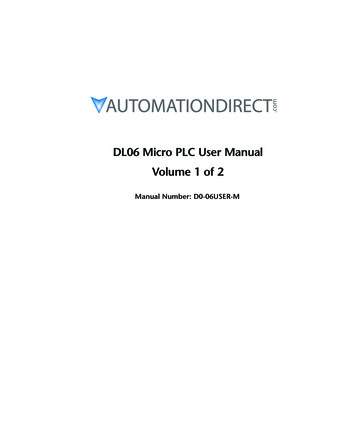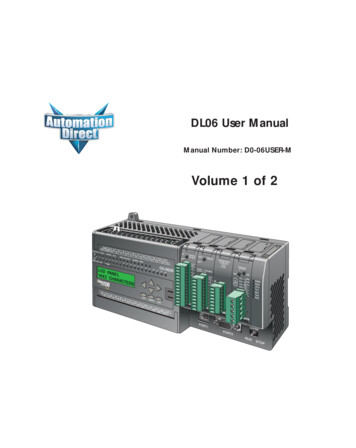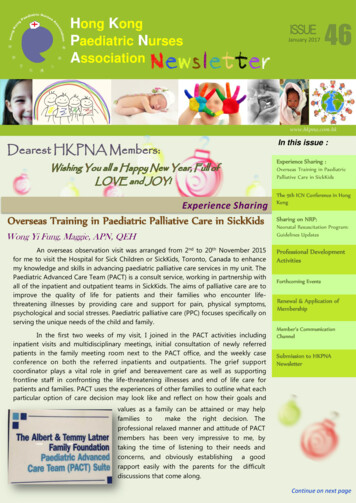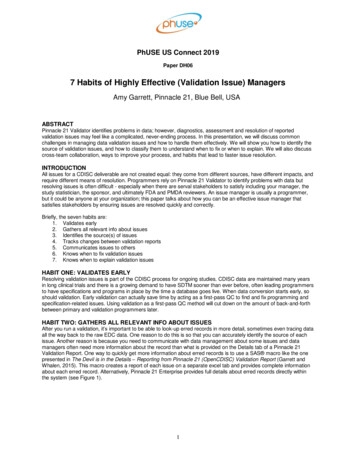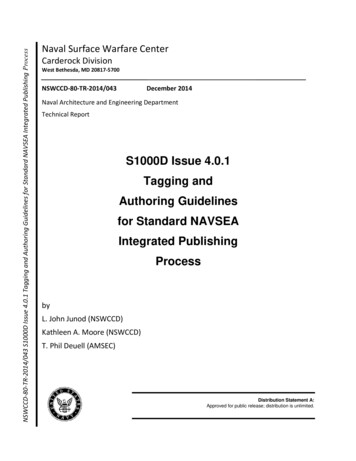
Transcription
NSWCCD-80-TR-2014/043 S1000D Issue 4.0.1 Tagging and Authoring Guidelines for Standard NAVSEA Integrated Publishing ProcessNaval Surface Warfare CenterCarderock DivisionWest Bethesda, MD 20817-5700NSWCCD-80-TR-2014/043December 2014Naval Architecture and Engineering DepartmentTechnical ReportS1000D Issue 4.0.1Tagging andAuthoring Guidelinesfor Standard NAVSEAIntegrated PublishingProcessbyL. John Junod (NSWCCD)Kathleen A. Moore (NSWCCD)T. Phil Deuell (AMSEC)Distribution Statement A:Approved for public release; distribution is unlimited.
NSWCCD-80-TR-2014/043Form ApprovedOMB No. 0704-0188Public reporting burden for this collection of information is estimated to average 1 hour per response, including the time for reviewing instructions,searching existing data sources, gathering and maintaining the data needed, and completing and reviewing this collection of information. Sendcomments regarding this burden estimate or any other aspect of this collection of information, including suggestions for reducing this burden toDepartment of Defense, Washington Headquarters Services, Directorate for Information Operations and Reports (0704-0188), 1215 Jefferson DavisHighway, Suite 1204, Arlington, VA 22202-4302. Respondents should be aware that notwithstanding any other provision of law, no person shall besubject to any penalty for failing to comply with a collection of information if it does not display a currently valid OMB control number. PLEASE DONOT RETURN YOUR FORM TO THE ABOVE ADDRESS.1. REPORT DATE (DD-MM-YYYY)2. REPORT TYPE3. DATES COVERED (From - To)30-06-2014Final30-06-2014REPORT DOCUMENTATION PAGE4. TITLE AND SUBTITLE5a. CONTRACT NUMBERS1000D Issue 4.0.1 Tagging and Authoring Guidelines for Standard NAVSEA IntegratedPublishing Process5b. GRANT NUMBER5c. PROGRAM ELEMENT NUMBER6. AUTHOR(S)5d. PROJECT NUMBERL. John Junod (NSWCCD); Kathleen A. Moore (NSWCCD)T. Phil Deuell (AMSEC)5e. TASK NUMBER7. PERFORMING ORGANIZATION NAME(S) AND ADDRESS(ES) AND ADDRESS(ES)5f. WORK UNIT NUMBERN0002413WX07048, N0002414WX060908. PERFORMING ORGANIZATION REPORTNUMBERNAVAL SURFACE WARFARE CENTERCARDEROCK DIVISION (CODE 821)9500 MACARTHUR BOULEVARDWEST BETHESDA, MD 20817-5700NSWCCD-80-TR-2014/0439. SPONSORING / MONITORING AGENCY NAME(S) AND ADDRESS(ES)10. SPONSOR/MONITOR’S ACRONYM(S)NAVSUP N00ALCOMMANDERNAVAL SEA SYSTEMS COMMANDATTN: SEA1333 ISAAC HULL AVE SEWAHINGTON NAVY YARD DC 2037611. SPONSOR/MONITOR’S REPORTNUMBER(S)12. DISTRIBUTION / AVAILABILITY STATEMENTDistribution Statement A: Approved for public release; distribution is unlimited.13. SUPPLEMENTARY NOTESN/A14. ABSTRACTThe purpose of the S1000D Issue 4.0.1 Tagging and Authoring Guidelines for Standard NAVSEA Integrated Publishing Process (SNIPP) is toprovide guidance in the development and sustainment of technical manuals compliant with MIL-DTL-24784C content requirements using theS1000D Issue 4.0.1 specification structure and organization. Appendix A provides technical manual authors with schema organization andstructure. The element and attribute tables allow quick reference to tagging instructions within S1000D and authoring instructions contained inAppendix B for S1000D SNIPP-compliant technical manuals. The guidance, actions, and processes described herein augment other TMdevelopment requirements such as the NAVSEA Technical Manual Management Program (TMMP) (NAVSEAINST 4160.3), and Technical ManualContract Requirements (TMCRs), which continue to apply for any NAVSEA S1000D TM development.15. SUBJECT TERMSTagging and Authoring, S1000D Issue 4.0.1, Standard NAVSEA Integrated Publishing Process, SNIPP16. SECURITY CLASSIFICATION OF:a. REPORTUNCLASSIFIEDb. ABSTRACTUNCLASSIFIED17. LIMITATIONOF ABSTRACTc. THIS PAGEUNCLASSIFIEDSAR18.NUMBEROFPAGES13519a. NAME OF RESPONSIBLEPERSONE. Lori Westbrook (NSWCCD);19b. TELEPHONE NUMBER (includearea code)301-227-3346
NSWCCD-80-TR-2014/043Table of Contents1. Introduction .11.1. SNIPP . 11.2. S1000D/MIL-DTL-24784C . 22. Conventions Used In This Document . 23. Feedback Reporting . 3Appendix A S1000D Schema Set SNIPP Tagging Guidelines for TechnicalManuals A-iAppendix B S1000D Schema Set SNIPP Authoring Guidelines for TechnicalManuals .B-ii
NSWCCD-80-TR-2014/043This page intentionally left blank.ii
NSWCCD-80-TR-2014/043Administrative InformationThe Technical Information Systems Branch (Code 8210) of the Future Concepts & Design IntegrationProcess Division (Code 82) of the Naval Architecture and Engineering Department (Code 80) at the NavalSurface Warfare Center, Carderock Division (NSWCCD), wrote this report. The work was funded by theNAVAL SUPPLY SYSTEMS COMMAND under work order numbers N0002413WX07048 andN0002414WX06090.iii
NSWCCD-80-TR-2014/043This page intentionally left blank.iv
NSWCCD-80-TR-2014/0431. IntroductionThe international specification S1000D was introduced to the United States Department of Defense(DoD) community to improve data interchange and increase interoperability during joint militaryoperations. S1000D improves standardization across product lines by developing one set ofdocumentation that can be delivered in multiple formats to support various product configurations.S1000D defines a documented approach to developing and maintaining technical documentationthrough ancillary requirements that accompany the specification. The use of such documented ancillaryrequirements as business rules and common content information sets allow the life cycle processes oftechnical data to follow a well-defined path. Other requirements, such as the development of technicaldata at a lower granularity, called data modules (DM), and the storage of these modules in a CommonSource Database (CSDB), support requirements to provide different-variant manuals from the same setof data.The purpose of the S1000D Issue 4.0.1 Tagging and Authoring Guidelines for Standard NAVSEAIntegrated Publishing Process (SNIPP) is to provide guidance in the development and sustainment oftechnical manuals compliant with MIL-DTL-24784C content requirements using the S1000D Issue 4.0.1specification structure and organization. Appendix A provides technical manual authors with schemaorganization and structure. The element and attribute tables allow quick reference to tagginginstructions within S1000D and authoring instructions contained in Appendix B for S1000D SNIPPcompliant technical manuals. The guidance, actions, and processes described herein augment other TMdevelopment requirements such as the NAVSEA Technical Manual Management Program (TMMP)(NAVSEAINST 4160.3), and Technical Manual Contract Requirements (TMCRs), which continue to applyfor any NAVSEA S1000D TM development.Before using this guidance, technical report Procedures for the Acquisition and Development of NAVSEATMS/IETMS in accordance with International Specification S1000D (NSWCCD-20-TR–2011/06) should bereviewed as it establishes uniform guidelines and practices for NAVSEA Activities and Programs withregard to the implementation of S1000D and is a companion document to the TMMP. The reportprovides an overview of the S1000D specification, key components of S1000D implementations, and isorganized to reflect the four phases of a TM’s life cycle: Definition, Development, Distribution, andDisposal, as addressed by the TMMP.1.1. SNIPPThe Standard NAVSEA Integrated Publishing Process (SNIPP) provides an S1000D process lane fordeveloping and sustaining technical manuals. The NAVSEA Data Content Management System (CMS)and NAVSEA Publishing Application (NPA) include the S1000D Common Source Database software, aswell as, the publishing software for producing technical manuals for printing and electronic display.NAVSEAINST 4160.3 establishes SNIPP under the cognizance of NAVSUP N00AL2 for the acquisition,development, maintenance, data storage, and distribution of NAVSEA TM source data and presentationfiles. The TMMP states NAVSEA TMs shall be acquired, developed, and distributed through this processwith the current components consisting of: Technical Data Management Information System (TDMIS),Streamlined Modular Acquisition Requirements Tailoring Tool (SMART-T), Naval Engineering TechnicalLibrary (NETL), Data CMS and NPA, Technical Data Knowledge Management (TDKM), and AdvancedTechnical Information Support System (ATIS). Using SNIPP assures proper integration of TM life cycledevelopment and distribution within the Navy infrastructure.1
NSWCCD-80-TR-2014/0431.2. S1000D/MIL-DTL-24784CIn the development of NAVSEA technical manuals, developers will utilize S1000D’s organization anddocumented approach through the specification’s ancillary requirements. MIL-DTL-24784C is utilized asNAVSEA’s authoritative source for the development of the ancillary documents for business rules andcontent information sets. In the development of the ancillary requirements and Technical ManualContract Requirements (TMCRs)/Technical Manual SEATASK Requirements (TMSRs), conflicts betweenS1000D and MIL-DTL-24784C requirements were resolved by Naval Surface Warfare Center CarderockDivision (NSWCCD), Naval Systems Distance Support Activity (NSDSA), and the NAVSEA S1000DConfiguration Control Board with representatives from the NAVSEA Programs working S1000D projects.NAVSEA S1000D ancillary documents and tools can be found at the NSWCCD tecinfsys/s1000d/index.html).S1000D covers the planning and management, production, exchange, distribution, and use of technicaldocumentation that support the life cycle of the project. The specification adopts InternationalStandards Organization (ISO), Continuous Acquisition and Life-cycle Support (CALS) and World WideWeb Consortium (W3C) standards, in which information is generated in a neutral format. Informationproduced is created in a modular form, called a "data module". A data module is defined as "thesmallest self-contained information unit within a technical publication".1MIL-DTL-24784C establishes the general acquisition and development requirements needed to preparedigital technical information for multi-output presentation of NAVSEA technical manuals. The technicalcontent and style and format requirements are used to develop and assemble complete TMs for ships,shipboard systems, and equipment. The requirements apply to the output of paper technical manuals orto the display of page-oriented linear and non-linear Interactive Electronic Technical Manuals (IETMs).Technical manuals developed in accordance with this specification are intended for use in theinstallation, operation, maintenance, repair, personnel training and logistics support of weapon systemsand equipment or for accomplishment of assigned missions.21S1000D, Issue 4.0.1, Chapter 1.2, Paragraph 2MIL-DTL-24784C, Paragraphs 1.1 and 6.1.22. Conventions Used In This Document Non-empty XML element names within the text are presented in Courier New font andbetween and characters preceded by the word element (e.g., element para ). XML empty element names within the text are presented in Courier New font between the and / delimiters (e.g., unverified/ ). Element attribute names within the text are presented in Courier New font and enclosed bysingle quotes (e.g., 'securityClassification'). Values for attributes within the text are presented in Courier New font and enclosedbetween double quotes (e.g., securityClassification "01"). Tagging examples are indented and are presented in Courier New font.Examples: language languageIsoCode "sx" countryIsoCode "US"/ language languageIsoCode "de" countryIsoCode "AT"/ reasonForUpdate id "rfu-001" updateHighlight "1"updateReasonType "urt02" simplePara The tool set ischanged. /simplePara /reasonForUpdate Elements and attributes that are mandatory within S1000D or are mandatory for NAVSEA aredenoted with (M). Elements and attributes that are optional are denoted with (O).2
NSWCCD-80-TR-2014/0433. Feedback ReportingBeneficial comments and any pertinent data which may be of use in improving this document should bereported via email to nswccd.code20web@navy.mil or in hardcopy addressed to:COMMANDERNAVAL SURFACE WARFARE CENTER9500 MACARTHUR BLVDW. BETHESDA, MD 20817-5700ATTENTION: CODE 803
NSWCCD-80-TR-2014/043This page intentionally left blank.4
NSWCCD-80-TR-2014/043Appendix A S1000D Schema Set SNIPP TaggingGuidelines for Technical ManualsA-i
NSWCCD-80-TR-2014/043This page intentionally left blank.A-ii
NSWCCD-80-TR-2014/043Appendix A Table of ContentsA.1. Scope . A-1A.2. General . A-1A.3. Introduction . A-2A.3.1. Technical Manuals . A-3A.3.2. Information Sets . A-3A.3.3. Schemas . A-3A.3.3.1. Elements and Attributes . A-4A.3.3.2. S1000D Data Dictionary . A-4Appendix A List of TablesTable A-1 List of NAVSEA Covered Schemas . A-6Table A-2 contains all elements and attributes for the following schemas: pm.xsd,descript.xsd, ipd.xsd, proced.xsd, fault.xsd, crew.xsd, checklist.xsd, process.xsd, andcontainer.xsd. . A-13Table A-3 contains all elements and attributes for the following schemas:appliccrossreftable.xsd, condcrossreftable.xsd, prdcrossreftable.xsd, brex.xsd, ddn.xsd, anddml.xsd. A-41A-iii
NSWCCD-80-TR-2014/043A.1. ScopeThis document provides technical manual authors with schema organization and structure along withelement and attribute tables for quick reference to tagging instructions in S1000D and authoringinstructions in Appendix B for S1000D SNIPP-compliant technical manuals.The guidance in tagging basic constructs is as defined in the S1000D XML Schema Sets for Issues 4.0.1and later and as specified in the applicable Technical Manual Contract Requirement (TMCR) or TechnicalManual SEATASK Requirement (TMSR). The TMCR/TMSR requirements are based on tailoredrequirements originating from the Detail Specification MIL-DTL-24784C and International SpecificationS1000D. These guidelines apply to the development of page-based (linear) TMs as well as frame-based(non-linear) Interactive Electronic TMs (IETMs). Unless otherwise specified in these tagging guidelines,the term “IETM” is used to denote both page and frame based TMs. Users are cautioned that they mustreview and comply with specified requirement documents cited in the TMCR/TMSR. These taggingguidelines are in no way a substitute for the TMCR/TMSR. In addition, these guidelines assume the userhas a working knowledge of tagging XML data.If maintaining manuals written using S1000D XML DTDs for Issues 3.0 and earlier, this guidance willprovide limited assistance. Users will need to determine the detailed relationships between thedifferent elements and attributes by comparing the earlier issue to Issue 4.0.1. Updating XML instancesto schemas Issue 4.0.1 and later are not necessary because the NAVSEA toolsets are compatible withIssue 2.2 forward.The guide will cover the following schemas: se schemas will not be covered: learning.xsd, scormcontentpackage.xsd, wrngdata.xsd, wrngflds.xsd,dc.xsd, rdf.xsd, schedul.xsd, techrep.xsd, comment.xsd, process.xsd, and xcf.xsd.A.2. GeneralA characteristic of S1000D is that it outlines an open systems approach to the production of technicalpublications. The specification does not take into account any specific tool or other proprietary solution.It is important to recognize that system and tool independence is a necessity for interoperability acrossdistributed S1000D implementations.A-1
NSWCCD-80-TR-2014/043The S1000D XML schemas must be used as supplied and shall not be modified or changed by a Programor Project. However, a Program or Project can configure various attribute values within the schemasfollowing the guidelines defined within S1000D, NAVSEA business rules, and TMCR/TMSR. The S1000Dformal change process detailed in the specification provides a mechanism to request schema and otherS1000D changes using a Change Proposal Form (CPF). All CPFs from NAVSEA shall be provided to NSWCCarderock for review and submittal. The CPF will then be vetted through the international committeesfor concensus approval into a future Issue of the specification or denial.A.3. IntroductionS1000D was completely revised in August 2008 with Issue 4.0. The revision renamed elements andattributes, enhanced some schema structures, and included numerous other updates resulting from theadoption of new policies for maintaining quality and consistency in the schemas. The revision no longersupported Standard Generalized Markup Language (SGML) and SGML/XML DTDs. Issue 4.0 is notbackward compatible with Issue 3.0 and earlier but third-party translation tools have been developed.NAVSEA Programs do not need to convert earlier Issues because NAVSEA toolsets support all versionsfrom 4.0.1 backwards to Issue 2.2 and will support newer versions as toolsets become updated.The S1000D schemas were revised with the following objectives:1) Modular form. The master schemas have a modular form that provides a good basis for simple andsafe maintenance of the schemas by the schema developers and maintainers.2) Compliance with standards. The prime structure of the schemas reflects the S1000D specificationand complies with W3C recommendations.3) Versatile implementation formats. The modular master schemas enable schema developers andmaintainers to perform simple automatic generation of the data module structures into flattenedschemas for use by technical manual authors.4) Backward compatibility. Subsequent versions of the schemas are backwardly compatibile with theinitial schemas as much as possible.The schemas are highly modularized into several parts where each part defines objects of a certain type(e.g. "complexType" schema objects) where each schema fragment is focused on its specificcharacteristics and substructures. The application schema, representing specific types of data modules(e.g. descriptive, procedural), is then composed by invocation of a suitable selection of the parts. Thisvariant of the schema package is usually referred to as the "modularized XML Schema package" and isthe master used by the S1000D schema developers and maintainers for maintenance and developmentof the S1000D technical base.In addition to the modularized package there is also a package of non-modular, flattened Schemas,where each application schema file contains most needed objects reused from the modular form(exceptions are xlink, rdf and dc fragments, refer to S1000D, Issue 4.0.1, Chapter 7.3). This flattenedschema package is generated from the modular package and is used by authors to tag documents.The S1000D schemas for data modules also consist of entities which are specific to a type of datamodule as specified in S1000D, Issue 4.0.1, Chapter 3.9.5.2. An entity is a character string which, in thefinal data module output, will be replaced by a character, symbol or an external file. Many contentmanagement systems manage entities separately from the Authoring Tool in which case the tool withinthe content management system is probably auto-generating the entity file names for the author. Theauthor needs to be aware of the available entities that such a tool has created so that the author caninsert these entities within their source XML. This will require an initial connection to the CMS prior toauthoring (to download the names of the entities) by the authoring tool.A-2
NSWCCD-80-TR-2014/043NAVSEA S1000D technical manual developers should understand the relationships between thetechnical manual (e.g. data module and publication module), information sets, and schemas. Theinformation sets define the technical manual’s content requirements and basic content organizationallayout. NAVSEA’s information sets were derived from MIL-DTL-24784C. The S1000D schema describesthe structure of the technical manual and controls which elements can appear in an XML instance and inwhich order. The schema also defines the rules for attributes and entities and provides data typeconstraints which describe valid units of data.A.3.1. Technical ManualsTechnical manuals are developed using many data modules to cover the technical manual’s definedcontent scope and depth. An author reviews the content requirements through information sets anddetermines both how the information will be presented (e.g. descriptive, procedural, troubleshooting,illustrated parts breakdown) and the number of data modules needed for the technical manual. Inmany cases, the information set will provide the schema type(s).For NAVSEA, all technical manuals will start with a publication module using the pm.xsd schema. Theminimum schemas needed to develop a descriptive only TM would be the primary publication moduleschema (pm.xsd), one or more descriptive data modules (descript.xsd) and other pm.xsd schema, thedata module requirement’s list (DMRL DID), and a BREX schema (brex.xsd), if the BREX schema is notalready available.A data module (DM) is a stand alone information unit comprising of descriptive, procedural, operationaldata for a material or a component. The unit is produced in such a form that it could be storedanywhere and retrieved from a Common Source DataBase by the data module code as the identifier.DMs are produced in XML according to specific schema. DM schemas are divided into the Identificationand Status section and the Content section. Refer to the Tables A-2 and A-3 and Appendix B forinstructions on how the specific elements and attributes are to be tagged.A.3.2. Information SetsAn information set defines the detailed depth and breadth of the content requirements that must becovered in a data module, set of data modules, or publication. The detailed content requirementsattempt to ensure that consistent, adequate coverage is delivered to operators and maintainersperforming their duties. For NAVSEA, 25 information sets were developed to cover the content of the11 technical manuals defined within MIL-DTL-24784C. The NAVSEA information sets aid in the discoveryof reusable DMs by content developers and the creation of reliable searches for end users.The NAVSEA S1000D information sets define the recommended S1000D information codes matched tothe content requirements extracted from MIL-DTL-24784C. For each content requirement, arecommended schema and info code or codes are provided to prepare the data module. Therecommended schema is based on how MIL-DTL-24784C defines the content requirement to identifywith one of the S1000D schemas (e.g. descriptive, procedural (with steps). The info coderecommendations are a best match based on an analysis and comparison of MIL-DTL-24784C contentrequirements and the long definition of S1000D info codes. Where conflicts exist between the contentrequirement and the long definition, the content requirement takes precedence.A.3.3. SchemasTable A-1 provides a list of schemas used in NAVSEA technical manuals. The table provides the schemaname, schema file name, schema description or purpose, and the S1000D chapter reference. Theschemas are listed in order by probably use.A-3
NSWCCD-80-TR-2014/043A.3.3.1. Elements and AttributesTables A-2 and A-3 contain all the elements and attributes for specific schemas, along with theirreference to an S1000D Chapter and Appendix B paragraph. The tables also provide a view of whichelements and attributes are common to specific schemas. There are many references available withinS1000D for each element and attribute. The single reference selected was either the first reference witha definition, the most logical reference for its use (e.g. elements for Identification and Status section of aDM), or the schema chapter where the element or attribute was only in one schema. Appendix B willcover the major elements and attributes but not all.Table A-2 contains all the elements and attributes for schemas: pm.xsd, descript.xsd, ipd.xsd,proced.xsd, fault.xsd, crew.xsd, checklist.xsd, process.xsd, and container.xsd. Table A-3 contains allelements and attributes for schemas: appliccrossreftable.xsd, condcrossreftable.xsd,prdcrossreftable.xsd, brex.xsd, ddn.xsd, and dml.xsd.Note: The dml.xsd elements are provided for informational purposes; however, for NAVSEA Programs,the DMRL spreadsheet shall be created per DID: DI-TMSS-81805, S1000D Data Module RequirementsList.A.3.3.2. S1000D Data DictionaryThe complete S1000D schema documentation from www.s1000d.org is downloadable for easy useoffline. The documentation can be searched for elements in a specific schema or just for an element.The following information can be found: element gives the name of an element within the start-tag delimiters (as it would be used withinthe data module instance)group gives the name of an element group (element groups do not appear within a data moduleinstance)complexType gives the name of a complex type (complex types are used for schemamanagement and do not appear within a data module instance)simpleType gives the name of a simple type (simple types are used for schema managementand do not appear within a data module instance)attributeGroup gives the name of an attribute group (attribute groups do not appear within adata module instance)diagram gives a graphical representation of the content of an element, group, complexType,simpleType, or attributeGroup using symbols as defined in S1000D Chapter 3.9.5namespace gives the namespace of an element, simpleType, or attributeGroup which is definedoutside of the S1000D namespacetype gives whether an element is a simpleType or complexTypeproperties gives information about the element, simpleType or complexType such as whethermixed content is allowed, the base type, and whether simple or complex content is allowedchildren gives the list of elements contained by this element, group, or complexTypeused by gives the list of elements, groups, complexTypes and attributes containing this element,group, complexType, simpleType, or attributeGroupattributes gives the list of attributes contained by this element further divided into the followingfields:o Name gives the name of the attributeA-4
NSWCCD-80-TR-2014/043oo Type gives the simpleType of the attributeUse gives the cardinality of the attribute No value indicates the attribute is optional required indicates the attribute is requiredo Default gives a default value for the attribute which can be overriddeno Fixed gives a value for the attribute which can not be overriddeno Annotation is not usedfacets gives any restrictions on the content of an element or simpleType expressed as a patternof allowable valuessource gives the schema fragment defining this element, group, complexType, simpleType, orattributeGroupA-5
ble A-1 List of NAVSEA Covered SchemasSchema FileDescription/PurposeS1000D ChapterNameReferencepm.xsdPublication Module Schema is utilized to Chapter 4.9.2bundle other PMs and data modules fora common theme (e.g. technicalmanual). The publication moduledefines the content through itsstructure and references to datamodules, other publication modules, orlegacy data.DescriptiveDMdescript.xsdProcedure DMproced.xsdA set of data modules, which have beenarranged to make a publication,checklist, guide, catalogue, etc on aparticular subject, irrespective of themedia of presentation (e.g. paper orscreen). The PM schema uses thepublication module code as theidentifier.A descriptive DM provides the narrativestructure for a TM and captures andrepresents descriptive information. Thegranularity of descriptive data modulesmust follow the breakdown reflected bythe SNS providing descriptions atsystem, subsystem, and sub-subsystemlevels as required by the maintenancephilosophy and scope of informationrequired.A procedural DM provides theprocedural steps in a TM by capturingand representing proceduralinformation. The granularity ofmaintenance procedural data modulesis to follow the breakdown reflected bythe SNS, the information codes andshould reflect the tasks identified in themaintenance plan. The granularity ofcrew/operator procedural data modulesis to follow the breakdown reflected bythe SNS, information codes and shouldreflect the operation identified.Chapter 3.9.5.2.2Chapter 3.9.5.2.3A-6
NSWCCD-80-TR-2014/043SchemaNameFault DMCrew DMIPD DMChecklist DMTable A-1 Lis
carderock division (code 821) 9500 macarthur boulevard west bethesda, md 20817-5700 9. sponsoring / monitoring agency name(s) and address(es) 10. sponsor/monitor’s acronym(s) navsup n00al commander naval sea systems command attn: sea 1333 isaac hull ave se wahington navy


